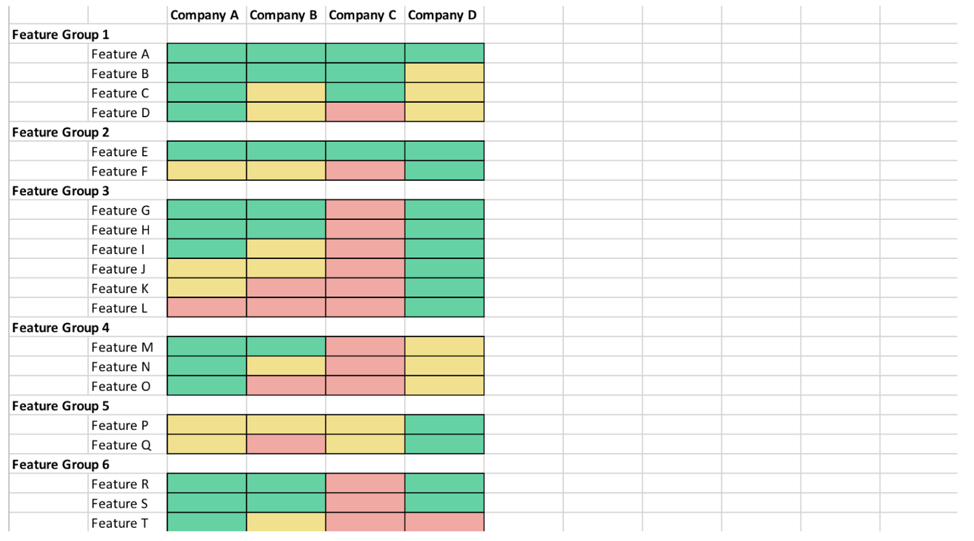84% of businesses say their industry has gotten more competitive in the last three years, according to the 2021 State of Competitive Intelligence. In the same report, 53% of respondents said the majority of their sales deals are competitive. So what does this mean? It means that markets are getting more competitive and will continue to do so, and enabling your sales team to sell against the competition is more important than ever.
Competitive selling is very common, but sales reps can sometimes get thrown off their game when they are going head to head with a competitor. However, that doesn’t need to be the case, as Gong.io found that competitors coming up in sales cycles often correlates to a higher win rate.
So while competitive selling is often a good thing for your sales team, it’s only successful if they are educated on your competitors and their products/services. If a sales rep says something incorrect about your competition, they will come across as uninformed or even worse—untrustworthy.
When it comes to the competition, it’s essential that sales is in the loop. Here are five tips that will help your sales team sell more effectively in head-to-head deals and crush the competition with confidence.
Take your strategy to the next level with the Ultimate Guide to Sales Enablement
Tip #1: Tailor Sales Presentations for Competitive Situations
Every company has a slide deck that gives prospects an overview of their company and solution. This will likely be the content your sales team will leverage the most, since they should be using it to kick off every prospect relationship. However, you’ll want to have several versions of the presentation so sales reps can customize their conversation for the prospect—especially in competitive situations.
Create specific slides for your Tier 1 competitors that reps can easily slot into the master presentation for any competitive deal. These slides should position yourself against your competitors in a way that highlights your differentiators and value to the prospect. It shouldn’t be a head-to-head comparison or a feature checklist—sell on the value of your differentiators and speak to the prospect’s pain points.
Tip #2: Integrate Battlecards Into CI Sources & CRM
Battlecards are one of the most common sales enablement tools used by teams today. A sales battlecard should give an overview of a competitor’s company, product, and services, and also provide instructions for your sales reps on how to win deals against specific competitors. Battlecards should NOT be a detailed checklist or feature comparison—that’s what competitor comparison matrices are for (keep reading if you want to learn about that, too!). Battlecards are about winning—not comparing.
Two common issues with battlecards is that they are often static documents that become outdated immediately, and sales reps never know where to find them. Here is how you can combat that.
Hook Up Battlecards to Your CI Sources
Oftentimes battlecards become out of date the moment you hit “publish,” and that’s bad news for many reasons—the most important being that if a sales rep says something incorrect regarding a competitor, they will lose trust and credibility with the prospect. If the trust is gone, then the deal is over—essentially, having no battlecard at all is better than an outdated battlecard.
Integrating your battlecards directly into your competitive intelligence sources will help you keep them updated and your sales team ready to sell.
CRM or Sales Enablement Integration
The best way to get sales reps to leverage your battlecards is to keep them where they spend most of their time. In most cases, reps spend most of their time in a CRM or sales enablement platform. Integrating your battlecards with your CRM will help reps pull up a competitor battlecard on the fly, and save you another “where do I find the battlecards?” email.
Tip #3: Send Weekly Competitive Intelligence Digests
A great way to keep your reps sharp is to provide a weekly (or bi-weekly, monthly, etc.) competitive intelligence digest so they can understand the broad moves competitors are making in the market.
Here are some key competitor insights you can include in your CI digest:
- Messaging & positioning changes
- Pricing changes
- Key website pages added or removed
- New third-party product reviews (e.g., G2, TrustRadius)
- New employer reviews (e.g., Glassdoor)
- News & PR Mentions
Sales reps are busy people and just want to know the information—so, keep the digest short and sweet and most importantly—add context to insights. Connect the dots for your sales reps so they can quickly leverage information and sell more effectively.
Tip #4: Create Detailed Comparison Matrices
All sales reps inevitably get the question “so how are you different from competitors A and B?” And when that question comes, the best thing they can have is a competitive comparison matrix.
There are several different types of comparison matrices out there, but the most useful for sales reps is a feature comparison matrix. A feature comparison matrix is a detailed document that compares the functionality and capabilities of your product against your competition. This can be really useful for reps when they’re speaking with a more technical buyer, or if the buyer is also the end-user who will leverage your product on a daily basis.
Here’s an example of a simple feature comparison matrix. If you have a lot of information, grouping by features or color coding can help reps quickly spot trends.

Tip #5: Quiz Your Reps on the Competition
Whether you’re doing sales training on a monthly or quarterly basis, it’s essential that your reps are learning the key concepts you’re providing and leveraging those concepts on sales calls. Creating a simple quiz on your competitors can help you gauge your reps’ knowledge on the competition and market overall.
Quizzes also help assess where you might need to improve your product marketing or sales enablement efforts—if reps are doing poorly on a quiz for a certain competitor, you know that you need to provide additional training or content on that competitor to help reps level up their knowledge.
Here are some quizzes you can implement for your sales team:
- Competitor comparisons
- Product feature quizzes (Us or Them?)
- Messaging & positioning quizzes
Try using quizzes periodically to make sure your reps are keeping abreast of the competition.
Creating Your Assets
Want to get started right away? Here are some programs you can use to create any of these assets:
- Sales presentations: PowerPoint, Google Slides, Canva
- Battlecards: Crayon
- CI digests: good old fashioned email, or any marketing automation tool like HubSpot if you prefer to automate. Use Crayon to collect and surface relevant competitor movements
- Competitor comparison matrices: Excel, Google Slides, Canva
- Sales quizzes: Typeform, SurveyMonkey, Google Forms
As markets get more competitive, you’ll want to implement any (or all) of these tools to give your reps confidence in head-to-head selling situations.

Seeing is believing! Check out Crayon for yourself.
Take a Product TourRelated Blog Posts
Popular Posts
-
 The 8 Free Market Research Tools and Resources You Need to Know
The 8 Free Market Research Tools and Resources You Need to Know
-
 6 Competitive Advantage Examples From the Real World
6 Competitive Advantage Examples From the Real World
-
 How to Create a Competitive Matrix (Step-by-Step Guide With Examples + Free Templates)
How to Create a Competitive Matrix (Step-by-Step Guide With Examples + Free Templates)
-
 24 Questions to Consider for Your Next SWOT Analysis
24 Questions to Consider for Your Next SWOT Analysis
-
 How to Measure Product Launch Success: 12 KPIs You Should Be Tracking
How to Measure Product Launch Success: 12 KPIs You Should Be Tracking


